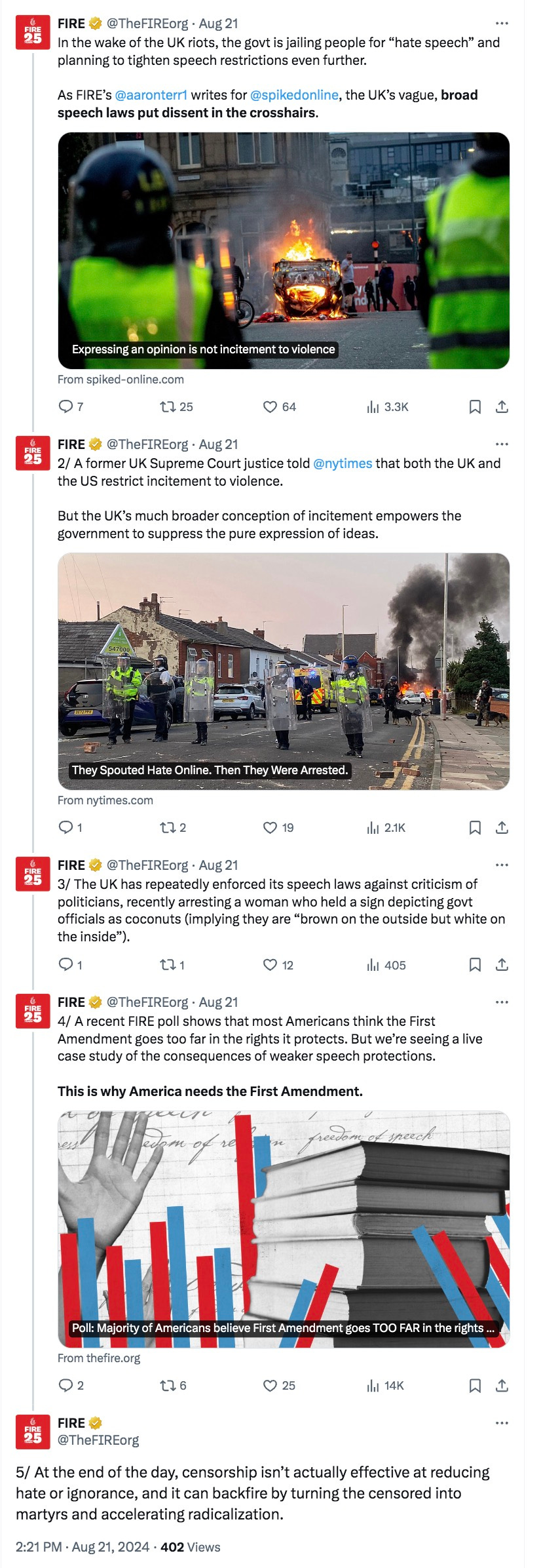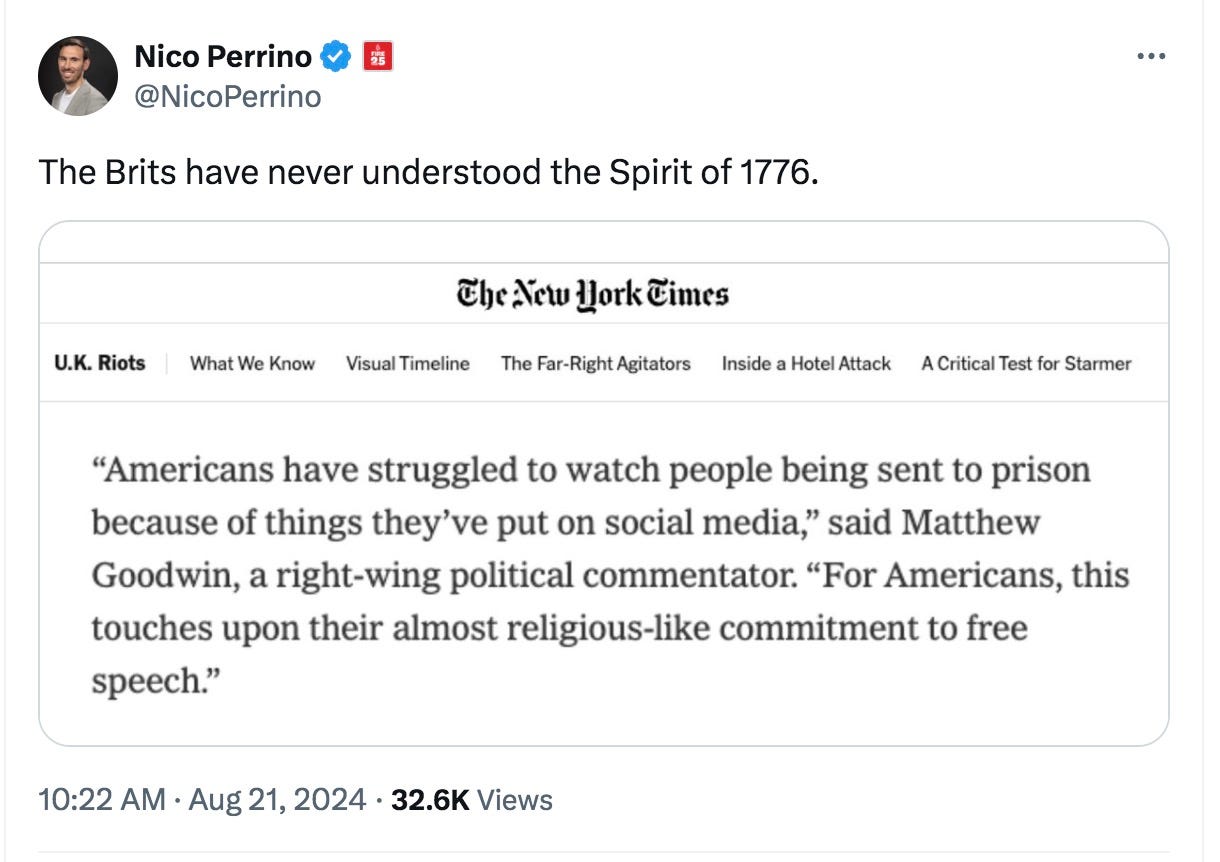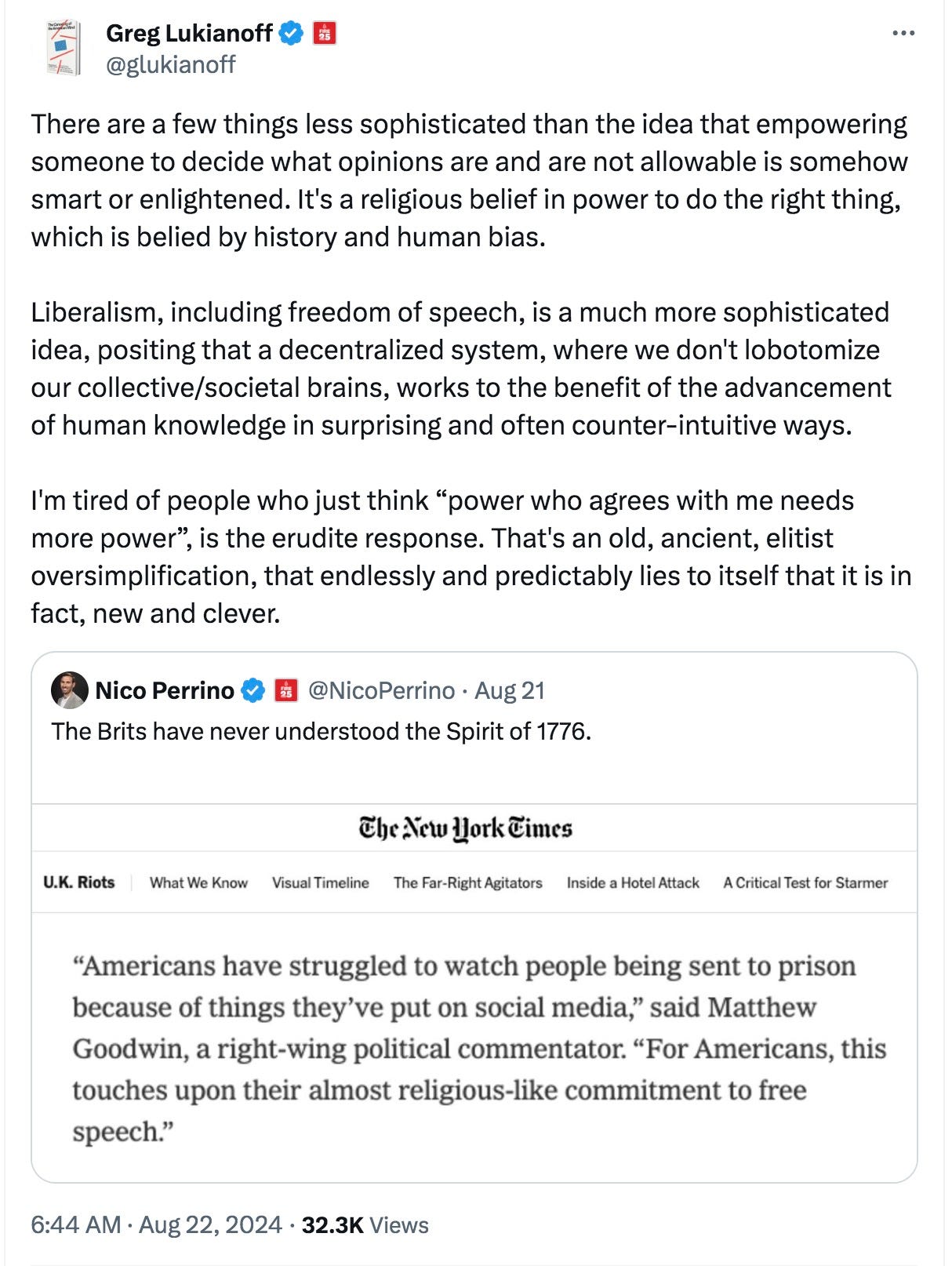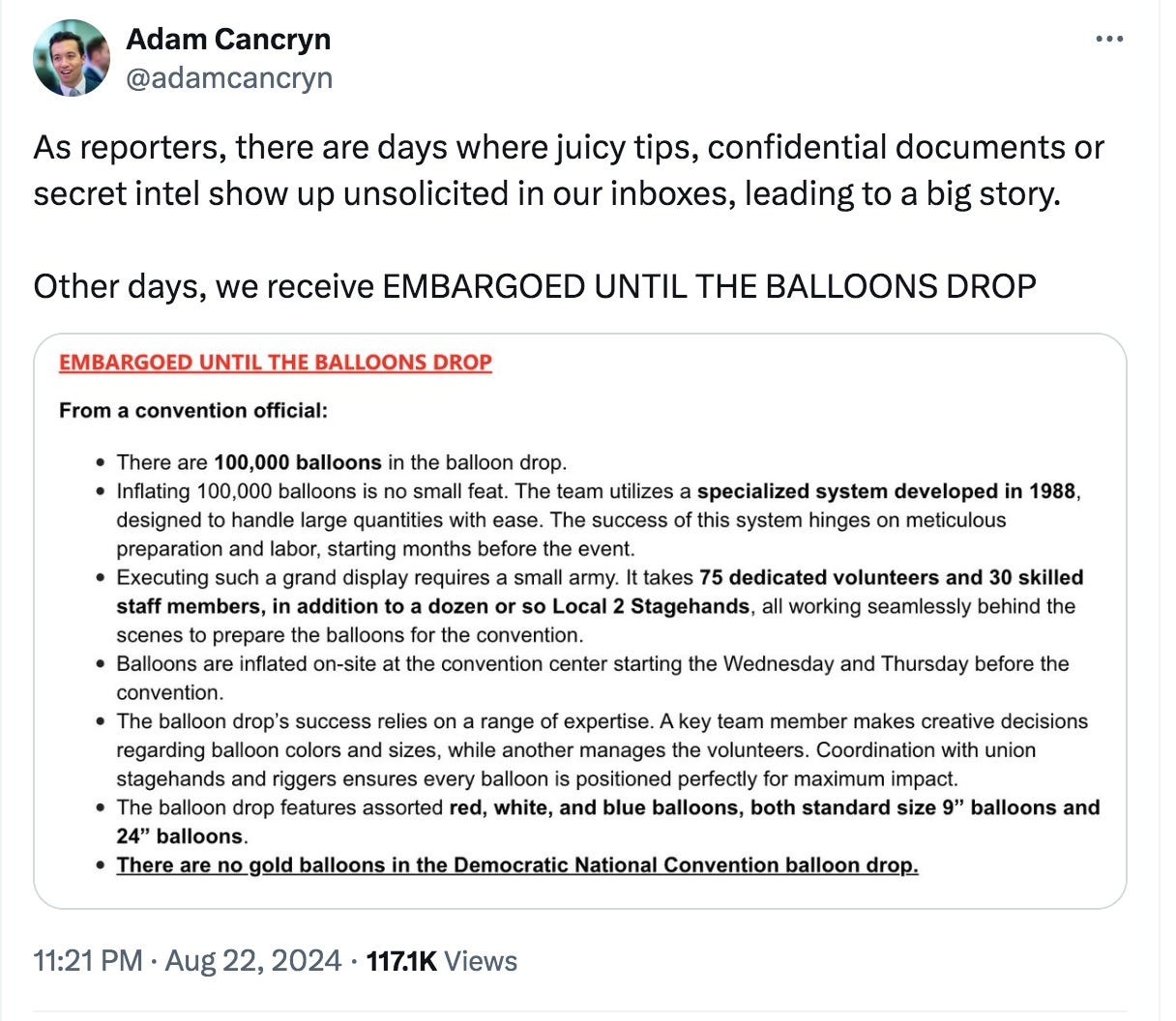E-Pluribus | August 23, 2024
America v Europe: who does it best? The source of media groupthink; and the nanny state can only do so much.
A round-up of the latest and best musings on the rise of illiberalism in the public discourse:
Reade Ben, Jordan McGillis: Greener on the Other Side?
Despite the way this City Journal article by Reade Ben and Jordan McGillis is titled, Americans and Europeans seem to generally believe the grass is greener on their own side of the Atlantic. Ben and McGillis consider some of the metrics used in such comparisons about the quality of life here and there and find the results are often in the eye (or perhaps the ideology) of the beholder.
[W]hile it is widely accepted that Americans are on average more productive and richer than Europeans, both America and Europe are sufficiently diverse and vast that generalizing isn’t that useful. Given that newcomers to the EU are still climbing out of the hole dug by Communism, a comparison with the richer corners of Europe is more apt. Moreover, Americans tend to work more for the money they earn. If we’re trying to puzzle out who has it better, it makes sense to adjust for the more plentiful leisure time afforded Europeans.
[I]f we assume American workers put in similar hours across the country, we can extrapolate that the richest eight American states per capita—New York, California, Massachusetts, Washington, North Dakota, Alaska, Delaware, and Connecticut (plus Washington, D.C.), are generating more wealth on average than The Economist’s standout European cluster of seven. And while the European group has a population of 50 million, our American subset combined has a population of more than 70 million. While two European countries (Luxembourg and Norway) still outstrip the richest American states per person (but not D.C.), they have a combined population less than that of New York City alone. And no European wants to see that wealth comparison.
There’s more to the question of life quality, however, than who has more money to spend; there’s the question of what you get for it. \
[. . .]
Consider two comparably sized cities, Berlin and Los Angeles. Berlin has a population of about 3.5 million; it spends about $2 billion annually on policing. Los Angeles has a nearly identical-size population and yet spends $3 billion on policing. New York spends more per capita, too, with its population of more than 8 million and a police budget of more than $5.5 billion. Berliners enjoy much safer streets than Angelenos or New Yorkers, but not because Americans are stingy on public safety spending. It’s a similar picture with transit, where Americans pay a lot but get lackluster returns. New York’s Second Avenue Subway expansion has come in at a cost of $2.5 billion per mile, ten times the per-mile cost Paris incurred for its impressive Grand Paris Express project.
These examples undermine Jukic’s hypothesis on causality but support his broader claim that life is in some ways better in Europe. In line with this mixed picture, the United States falls squarely in the middle of the OECD’s “life satisfaction” rankings, above the other English-speaking countries and France, Italy, Spain, and Belgium, yet below the Nordics, the Netherlands, and the German-speaking countries.
To recap: America is richer than just about all of Europe and happier than most of it, too. Yet some well-off European regions compare favorably, even if they lack the super-charged economic performance enjoyed by the most productive metros stateside, such as New York, the San Francisco Bay Area, Seattle, and Washington, D.C.
The ultimate question may be whether something in the less settled nature of America—a much shorter political history, more internal migration, greater cultural diversity—makes it both more economically dynamic and in some ways more dysfunctional, or whether the good can be bottled while the bad is discarded.
Read the whole thing.
Yascha Mounk: Why the Media Moves in Unison
Where does the herd mentality or narrative mentality in the media come from? Is there a grand conspiracy? A media illuminati? At Persuasion, Yascha Mounk suggests the answer is more mundane: dinner parties (or more broadly, social acceptance.) A short excerpt is below, but read the whole thing.
[T]rust in the media has fallen […] dramatically. It is rational, and even laudable, for journalists to change their mind as new evidence emerges. But when journalists ignore such evidence for weeks or months, only to change their tune all of a sudden, it is understandable, perhaps even inevitable, that many people will smell a conspiracy. When so many journalists march—and pivot—in lockstep, the simplest explanation seems to be that they are obeying a shared set of orders.
But it doesn’t take some grand conspiracy—which is unlikely for the same reason most conspiracies supposedly involving thousands of disparate individuals with competing incentives are implausible—to explain why the media coalesce around the same taboos. The real reason is rather more prosaic. Writers care about being read. They care about building a following. They care about making money. But more than any of these, they care about not being cast out of their social milieu.
This helps to explain how journalistic taboos form and wane. A certain fact or point of view seems to give succor to the wrong people. For rational or less-than-rational reasons, it is perceived to open the door to prejudice against Asian-Americans (lab leak); or to harm the fight for trans rights (cross-gender hormones); or to undermine efforts to contain the pandemic (school closures); or to weaken American democracy (Biden’s mental acuity). This is enough to render anyone who reports this fact or expresses this point of view suspect.
Over time, however, as evidence accumulates that the taboo belief is true, or that admitting to it would not lead to the terrible consequences journalists had previously imagined, it becomes harder and harder to ignore reality. What was once an organic social consensus is now propped up by the fear of social ostracism. And so the time is ripe for one person to break ranks, lowering the costs for subsequent people who dare to say in public what long ago they had started to whisper to each other in private.
The reason for the striking homogeneity in the opinions expressed in the mainstream press at any one time, and the seemingly choreographed manner in which these can suddenly change is not a conspiracy. It is, to put the phenomenon in the simplest terms, the desire of many journalists not to face awkward questions when they attend their next dinner party.
We crave money and power. We pursue physical safety and physical pleasures. We have ideals for which some of us have, on occasion, proven willing to die. But one of the most fundamental drives we have—one that, in many circumstances, trumps all these others—is the need for social connection and social approval.
The reasons for this go deep. For much of our history as a species, individuals who were cast out from their group were far more likely to die. Even today, many people find social humiliation as hard to bear as physical pain. Solitary confinement is, for good reason, considered a form of torture. In the history of warfare, many more people have been willing to die by marching in lockstep with their comrades than to save themselves by deserting from the group.
[. . .]
And that, it seems to me, is a more powerful motivator of human action in many milieus than the explanations that are more commonly offered. According to Hanlon’s Razor, we should never attribute to malice that which is adequately explained by stupidity. Similarly, it seems to me that we should never attribute to conspiracy that which is adequately explained by not wanting to be singled out at your next dinner party.
Read it all.
Washington Post Editorial Board: How government can cut kids’ social media use without doing more harm
The first two words (“how government”) of this Washington Post editorial are too often how discussions about societal problems begin. Even if social media use by children is a big problem, should the government be the one to try to fix it? The Post answers with a qualified yes, but recognizes the most effective remedies lie elsewhere.
U.S. Surgeon General Vivek H. Murthy wants warning labels on everyone’s favorite apps. Schools, including the 500,000-student Los Angeles public school system, have banned cellphones during the day. Some states want to go further, banning minors from using apps such as Instagram and TikTok — or at least require parental consent to use them. Congress is considering a bill that would penalize companies that don’t take “reasonable” measures to mitigate certain harms.
The catch is that researchers don’t know precisely what kind of content is harmful to which kind of kids, and people should not want platforms to censor young people’s speech or access to it. Clearer, however, is that sites are engineered to keep tweens, teens and adults, too, clicking at all hours, with features such as infinite scroll, autoplay and nonstop notifications drawing them in and keeping them staring. Legislators ought to devote their efforts to curbing these addictive tactics. Going beyond that, into content control, risks damaging the same young people these lawmakers are trying to protect.
Banning cellphones during the school day is an easy call: The foreseeable result is students focusing more on learning in the classroom and on in-person interactions in hallways. Banning social media for minors who fail to obtain explicit parental consent — as lawmakers in states such as Utah, Florida and Arkansas have sought to do — is a more dubious proposition. Some online experiences benefit young people, allowing them to express themselves in new ways or form connections with new people. These sites can serve as a source of comfort for LGBTQ+ kids lacking supportive home environments in particular.
Rules that require platforms to verify age — as those state social media bans explicitly did, and as other regulations requiring special protections for children often do in practice — come with real trade-offs. Driver’s license and Social Security numbers can be vulnerable to hacking. The same goes for biometric tools, such as face scans.
[. . .]
The science on whether social media is to blame for the crisis in youth well-being remains open to interpretation and debate. But it’s clear that some categories of smartphone use are harmful to some categories of teens and tweens. And screen time supplants activities known to be beneficial — such as spending time outside, or reading and playing with family and friends. The most prudent route to addressing the internet’s ills might also end up being the most effective: Give young people fewer reasons to stare at their screens so they have more time to touch grass.
Read it all here.
Around Twitter (X)
The Foundation for Individuals Rights and Expression with another warning about “hate speech” and the UK:
And Americans don’t wish to beat a dead horse, but there’s a reason we staged a revolution:
Finally, political parties are constantly feeding reporters hot tips when it comes to internal squabbles, but when it comes to balloons, they have no toleration for leaks.










